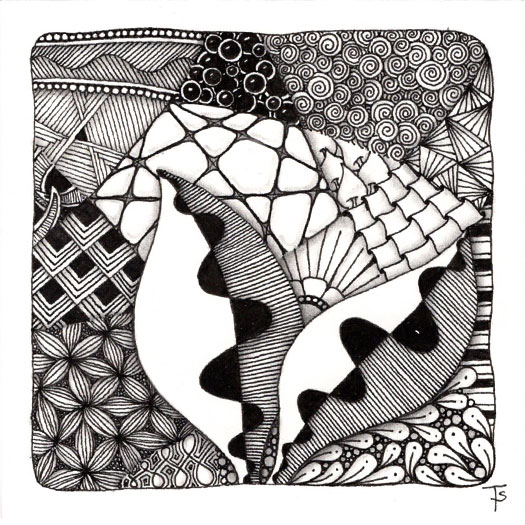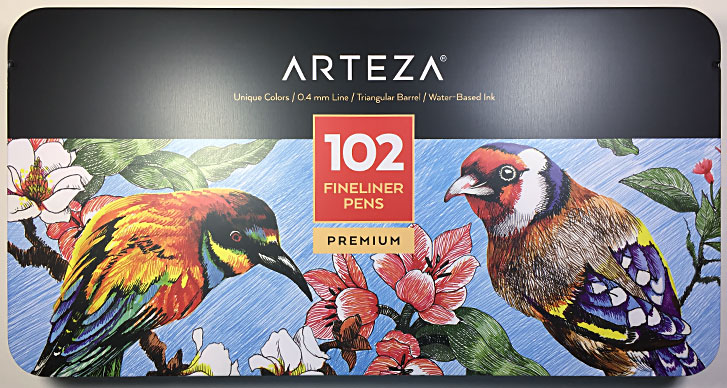I like to have a tile that has a complex string with a lot of different spaces. I can sit down and fill an area with a random tangle when I have a few moments. But I don’t have to work on it until it’s done. I just return to it when I have a short bit of time.
That means it may be sitting on my desk for a while before it’s finished!
I’ve posted Zentangles with a design similar to this tile before, here and here .
In addition, the other two examples have no shading or highlights. So I needed and example that included these additions.
I’m doing it again because I’m using it on a class project and I wanted it on a 3Z for my students to observe and discuss.
Zentangle drawn on black, Strathmore, Artagain paper using a white, Sakura, gel pen. Shading done with Copic Markers and black colored pencil. Highlighting done with General’s Charcoal White.
For me, this is the traditional way of drawing Shattuck. As an alternative, it could be done with straight lines, instead of curved. I do it both ways, depending on what I am working on.
Zentangle drawn on black, Strathmore, Artagain paper using a white, Sakura, gel pen. Shading done with Copic Markers and black colored pencil. Highlighting done with General’s Charcoal White.
Tangles: Shattuck
One of the things that I love about the “Crazy” versions of various tangles is how forgiving they are for those who struggle with perfection. Crazy ‘Nzeppel is a perfect example. Because each section ends up being a different, and some times surprising shape, each squished bubble doesn’t have to match any other!
Zentangle drawn on black, Strathmore, Artagain paper using a white, Sakura, gel pen. Shading done with Copic Markers and black colored pencil. Highlighting done with General’s Charcoal White.
Huggins is a favorite tangle for many, many people. Here, I’ve chosen to create it in a traditional manner, with added auras inside each shape.
When this was first drawn, it really didn’t look like much. But the addition of shading and highlighting brings it to life!
Zentangle drawn on black, Strathmore, Artagain paper using a white, Sakura, gel pen. Shading done with Copic Markers and black colored pencil. Highlighting done with General’s Charcoal White.
How do you practice drawing orbs? By drawing orbs!
I actually found it very relaxing to draw lots and lots of circles. I tried various methods, both drawing all the way around in one fluid motion and drawing a “C” shape for one side and then the other.
I learned that some sizes I can do very nicely, and some are harder to do. It’s important to turn the tile so that you can see what your doing. It made a big difference!
This deceptively simple tile was so meditative because I took my time with the linework.
A great trick to use, to get the spacing even is to “divide and conquer.” What I mean by that is to begin by dividing the space in half, vertically. Then divide each half in half again. Repeat until you are happy with the divisions.
Then divide the horizontal spaces. In the case of this tangle, they are equal to the width of the vertical divisions, making a square. Or there about.
Back to basics! I have never done a monotangle of Crescent Moon. I decided to tackle it yesterday on a 3Z-type tile, just to see what would happen.
Here’s the result!
Zentangle drawn on Stonehenge white using a black, Micron pen. Shading done with graphite and colored pencil. Highlights created with a white, charcoal pencil.
Tangles: Crescent Moon
I wanted to try this medallion-style tangle on a 3Z tile for a while now. I like the way it turned out, even though shading was a bit of a challenge. I ended up using some black colored pencil in the background areas to increase the contrast. I think that created a a very interesting look.
For even more contrast, I added a bit of white, charcoal pencil to create some highlights.
I wrote a bit about my Mother-in-law a while back. Today, as I was going through her stuff, I found a plastic box full of tiles. Inside were pre-cut blank tiles, completed Zentangles and a full set of tiles representing each letter of the alphabet.
Apparently, she use letter stencils to create the letter in the center and then used tangles who’s name begins with the same letter to decorate the tile.
Generally, now days, I use fewer tangles on a tile that I did when I began 10 years ago. But not always.
Yesterday, I decided to create a complex string and use a lot of different tangles. I had been looking through tiles from years ago and I wanted to see if I could still tangle in that style.
It took longer to choose the tangles than it did to draw them! 17 tangles is a LOT!
This tile was created following the instructions from Eni Oken ’s Art Club ’s latest lesson, Glazed Whitework .
It all started with a watercolor tile. It was an interesting challenge to draw the string and all of the tangles using a white colored pencil. Then more color was added creating the depth and shading you see here.
One of the most challenging things was to select appropriate tangles. It’s much more difficult to create detail with colored pencils than if you were using an inking pen.
My random tanglizer spit out a lot of tangles for practicing line work yesterday. At first, I was a bit worried that these wouldn’t produce enough contrast. But after using my magic wand (actually, a pencil), I like the way they became distinct and unique!
Zentangle drawn on Strathmore Vellum Bristol using a black, Micron pen. Shading done with graphite pencil.
Tangles: Fassett Flux Fracas Nzepple Sand Swirl Static Tipple Xircus
I mentioned, in a post last week , that I would do a review of the Arteza 0.4 fineliner pens. Here it is!
Note: this is not a paid review. This product was purchased from Amazon and not provided by Arteza for review.
I purchased this set of pens from Amazon along with a couple of other things. They arrived in a large box, with another box containing the pens inside. The pens, themselves, come packed in a very nice, hinged tin, as you can see in the image above.
I had a private class with a very artistic, imaginative young lady on Saturday. She wanted to know what the Zentangle method was, so we sat together and I taught the Basic Beginner’s Class.
She was so much fun to work with because she is already a gifted artist and has an inherent understanding of things like drawing behind, line weight, shading, and auras!
As I was showing her the way we do things in Zentangle, she was showing me how she does similar things. I learned a lot from her, and about her, and I’m looking forward to working with her again in the future!
Yesterday, I spent the morning with a group of friends who are also artists. While we chatted, each of us worked on our own projects.
My project was to transfer some pictures of strings that I drew several years ago to bijou-sized tiles. I keep these in the front section of my bijou tangle index.
Generally, when I tangle, I don’t have any problem creating a string. However, once in a while, I just want to push the easy button, and I will pick one of these little string examples and go with that.
How do you challenge yourself? As an artist I’m always looking for different things to try as ways to grow and expand my skills.
Here, this tile was drawn entirely with my left hand. I even signed and dated the back with my left hand.
Why?
Well, first of all, I wanted to see if I could. In addition, drawing with your non-dominant hand builds new neural pathways in your brain. It also challenges you to look at things in a different way, and helps you to understand how your students, those that use a differnt hand to draw, are challenged to follow your instructions!
This fabulous monotangle of Mooka was created by my Mother-in-Law, Twyla Baker.
As many of you already know, she passed away on June 27th. I am in the process of going through her artwork. I found a small, spiral-bound sketch book which contained many Zentangles.
Towards the end of the book, I found this monotangle of Mooka. It fills the entire 4-inch by 6-inch page! I’ve never seen this before and there is no date on it. Because the dates on other pages jump around and are not in consecutive order, I’m not sure when this was done. It was probably some time around 2013-2015.
Another DingsplatZ today! I’ve discovered that about 3 tangles, along with some perfs and dots works well for creating these! My favorite part, though, is the shading. It amazes me how much life it adds to the pen lines!
Zentangle drawn on kraft colored Stonehenge multi using black, sepia and brown, Micron pens and white gel pen. Shading done with graphite pencil and white charcoal pencil.
Tangles: Antidot Knase Ravel



















